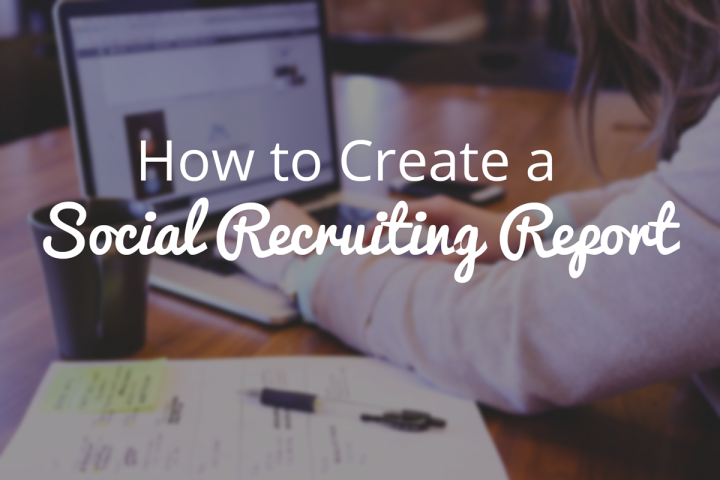
How to Create a Social Recruiting Report
So ...
You’ve rolled out your social recruiting strategy and have begun to see results…
You’re sharing job posts, promoting your company employer brand and engaging with candidates.
What now?
It’s time to let everybody else know about all of the great work that you’ve been doing! Creating a social recruiting report is the most effective way to communicate your progress.
Instead of just telling your boss what you’ve been up to why not show them?
With a social recruiting report you can use visuals to communicate ideas more clearly, charts and graphs to show your progress over time, and statistics as concrete proof of the progress that you’ve made.
Here’s how you can make your own social recruiting report.
Decide what to measure:
The data and statistics that you choose to include will fall into two categories: employer branding and recruiting.
For employer branding you’ll want to track:
Number of Clicks Per Post - This will show how interested your audience is in what you are sharing.
Shares/Retweets - This data is great for seeing how your content is received and how engaged your followers are. Shares are awesome because they mean that your brand is getting exposure amongst non-followers.
Likes/Favorites - Likes and favourites aren’t just about showing how many people enjoy your content, they also act as social proof to your other followers.
Followers - How many followers you have tells you the number of people who are interested in your company. Increasing your number of followers improves the reach of your content, your social proof, and increases the likelihood of job seekers finding you.
For recruiting, you’ll want to track:
Job Views by Source - Where people who view your job posts are coming from. This will help you learn where people are finding links to your job posts.
Applicants by Source - Where applicants are finding your job posts. This will help you learn which social networks are connecting you with potential hires.
Hires by Source - Where your actual hires are coming from. This will show you where the highest quality of candidates are coming from.
For each of these areas, you’ll want to gather information about where your social recruiting stands currently, how it has progressed over time, and how you think it will progress into the future.
How to Find Your Social Recruiting Stats and Data
For employer branding:
Facebook - Facebook Insights will give you all of the information that you need about Clicks, Shares, Likes, and Followers for your Company Facebook Page.
Twitter - Twitter Analytics are excellent for finding out all that you need to know to create your report.
LinkedIn Analytics for Business - LinkedIn’s analytics tool (located near the “Home” link on your LI business page) is nowhere near as insightful as those you’ll get from Facebook or Twitter, but it’s still the best/only tool out there for LinkedIn.
Google+ Insights - Google does a lovely job with their analytics tool and provides a simple, easy to read ‘audience overview’.
For recruiting:
This can be a little trickier!
You will either need to use an ATS that provides you with tracking, so that you can see where applicants come from, or use a social recruiting tool that provides you with the data you want to track.
Jobcast is just one of those social recruiting tools. It provides you with reporting that will show where your job views, applications, and hires are coming from. Jobcast’s reporting can also be used to see just how much traffic your social recruitment efforts are driving.
Creating Your Social Recruiting Report
Twitter, Facebook, and Google+ allow you to export all of your data to a CSV file.
Unlike Facebook and Twitter, Google+ requires a bit more than just clicking an export button to download your data.
This article explains how to download data from Google+ Insights.
Unfortunately with LinkedIn, you will have to create a CSV or Excel sheet manually!
For recruiting, getting the data will depend on the ATS or platform that you use for your social recruitment.
Once your data is ready to use, you’ll need to choose a presentation tool.
You can use Google Docs or Excel to build your social recruiting report, but I would recommend taking advantage of some of the amazing visualization tools available to you.
My favourite tool is Piktochart, as it is pretty easy to use and you can import data from Google Spreadsheets. You can even splurge and upgrade to a pro account to gain access to some excellent social media reporting templates.
Here’s an example of what a social recruiting report can look like with Piktochart.
Make sure to write a quick brief that explains the findings in your report. Explain the trends you see and speculate on why you think you’re getting those results.
After this summary is written, it’s time to lay out what your goals are for the future, and what you’ll need going forward to accomplish those goals.
Use the numbers presented in your report to develop actionable paths to these goals and to prove the ROI on what you’ve done so far.
What tools do you use to make reports? Let us know in the comments!





